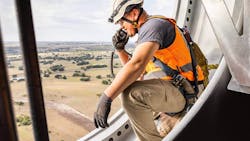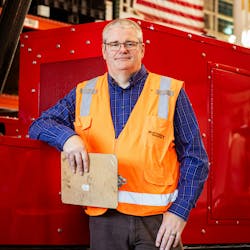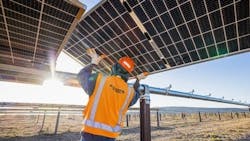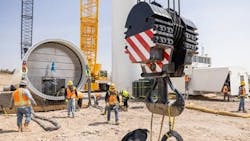How Tim Giggee Manages Maintenance at Blattner Co.
Tim Giggee, CEM, senior manager, CE Maintenance & Repair, Blattner Company, is second generation—he grew up around road construction, watching his dad turn wrenches as a senior mechanic.
“I’ve been around this forever, back to going into the shop on Saturday mornings and helping my dad get loaded out for the week,” Giggee says. “I started in this industry in 1995 as an oiler, chiseled my way in through persistence with a small contractor in Wyoming doing topsoil stripping at coal mines and worked my way up from there, learning lessons and working with a great crew of gentlemen.”
From there, Giggee moved up to mechanics’ jobs. He’s been in mining, aggregates, oil field, and with general contractors. He moved from the field into management during a stint with URS, where he became familiar with the Association of Equipment Management Professionals and its EMS program. Giggee currently serves as AEMP 2024-25 chairman.
Managing a shop and a maintenance planner role followed. But it was at Unimin out of New Canaan, Connecticut, where he went from being a planner to the “big show,” as Giggee calls it, helping to manage a global fleet of equipment.
Two years ago, he was recruited to join Blattner Company and run its maintenance program. Blattner is a nationwide firm that is all about renewable energy construction, putting up wind and solar farms, as well as adding battery energy storage facility construction.
Want to win a Fleet Masters Award? Start here
Blattner Company began specializing is renewable energy construction earlier than most of its competitors, Giggee says.
“You don’t have to have a very large crane to do solar, so it’s a little easier to get into it,” Giggee says. “We’re in a great position in that we’ve kind of hit all the [renewable energy construction] milestones first, being in it quite a bit longer than most of our competitors.
“From my end, that management of the ownership of the equipment, it’s making sure the lifecycle cost, all those things hit the bar to not just keep it running, but also keeping it running at a good cost,” Giggee says. “We need to make sure we’re disposing things at the right time in the cycle, as well.”
Blattner’s fleet encompasses everything from CTLs to some of the largest cranes on the planet. There are also many telehandlers, dozers, excavators, trenchers, and pile drivers. “If I get a survey and it asks what equipment we have, I just check all the boxes,” Giggee says.
Interestingly, the fleet is about 80% rental right now but has been increasing owned pieces.
“That number probably won't change a lot,” Giggee says. “We'll add more owned, especially in categories where it makes sense to, but a lot of it is that with the transient nature of our work, it's often easier to engage rentals in some of these classes of equipment and get them locally, especially where you don't see the life cycle benefits being there.”
Cost analysis has led to some adjustments.
“From the analytic side, we've done a lot of cost analysis,” Giggee says. “Sometimes we find ‘Owning these doesn't really benefit us in any manner.’ Telehandlers are a good example of that. It’s rough use that we see with them and we're asking them to do quite a bit. So, it’s a lot easier just to move those through as rentals, maybe keep them on long-term rent for a couple years and roll those out of the fleet to make sure the capital dollars are going in the right direction.”
The right direction for Giggee in these cases would be acquiring a crane or larger dozers, things that may be more difficult to find for rent.
Growing people
“With the scale and the size of the company we are, it can be fun in that there are so many people, so many different departments to work with,” Giggee says. “Even how we approach equipment's a bit different in that we're broken into different segments within the equipment group; one team does the analytics, and one team just does acquisitions. Another team manages cranes and then my team manages life cycle.”
That makes communication and team development vital. Giggee says one of the biggest things that has changed in his time in the position is personnel development.
“We’ve really opened up the door and started developing the people we have,” he says. “With growth and our acquisition by Quanta, we needed to scale up our maintenance operations, so it was time to get some more education for our folks. I think we had nine people acquire their CEMs through AEMP right off the bat.
“Give to the people, educate your folks, and they will give back,” Giggee says.
Succession in today’s labor shortage environment is a concern, but Blattner has some safeguards in place.
“One of the things we did is we went out and started creating apprenticeship programs through the Department of Labor,” Giggee says. “We got all the right boxes checked. We currently have a two-year oiler apprenticeship program and a four-year mechanic apprenticeship program. We make sure they get the education, the field time, everything else like that, and they should come out of that being very well-rounded individuals.
“I think we’ve risen to the challenge fairly well overall, but I do know it’s an industry struggle,” Giggee says. “We’re seeing a lot of support through social media, a lot of folks are doing that and really driving it. I’ve got a couple of good younger folks on my team, and they have been doing a good job of going out and getting people engaged and brought in.”
Passing knowledge
Giggee, whose term as AEMP chairman is up in March 2025, has tried to bring that emphasis on development to his time at the helm. Part of it is passing on knowledge to the younger generation.
“I’ve still got some time left in the industry and we have a great group of younger folks coming up. That’s been my role in AEMP, bridging generations and bringing that all together,” Giggee says.
He points out that while equipment managers are coming up both through the maintenance side and the equipment side, there are other disciplines stepping into the role.
“I talked to a gentleman in Oklahoma earlier while interviewing for board positions that was an attorney before coming into equipment,” Giggee says. “We see IT, finance, it’s all these different backgrounds because the job is so much more now than just managing equipment. You’re managing budgets, you’re managing those lifecycles, the analytics, and all the technology that goes in. You can come here from any path.”
Despite all the changes to the role and the use of different tools and technology, Giggee says the problem managers face is still the same: “How do we do more with less? How do we get there?”
“I’ve seen that as my bit in here, connecting the past with the future, weighing in the importance of both,” Giggee says. “If we forget where we came from, we are not going to go forward very well. But we don’t need to dwell on where we used to be, either. I’ve wanted to bridge those aspects and make sure we have a well-rounded group of folks from different backgrounds to drive the industry and make sure we’re providing the right education as AEMP.”
As for the organization’s future, it’s about adaptation to new technology.
“We’re looking at rewriting the CEM manual and refreshing the testing, but I think a lot of it is making sure that as the technology curve swings, that we keep up,” he says.
“I see more pairing with other organizations as we’re doing with CFMA on the Heavy Equipment Comparator and offering more education. We’re crowdsourcing how we’re going to do things.”
About the Author
Frank Raczon
Raczon’s writing career spans nearly 25 years, including magazine publishing and public relations work with some of the industry’s major equipment manufacturers. He has won numerous awards in his career, including nods from the Construction Writers Association, the Association of Equipment Manufacturers, and BtoB magazine. He is responsible for the magazine's Buying Files.




